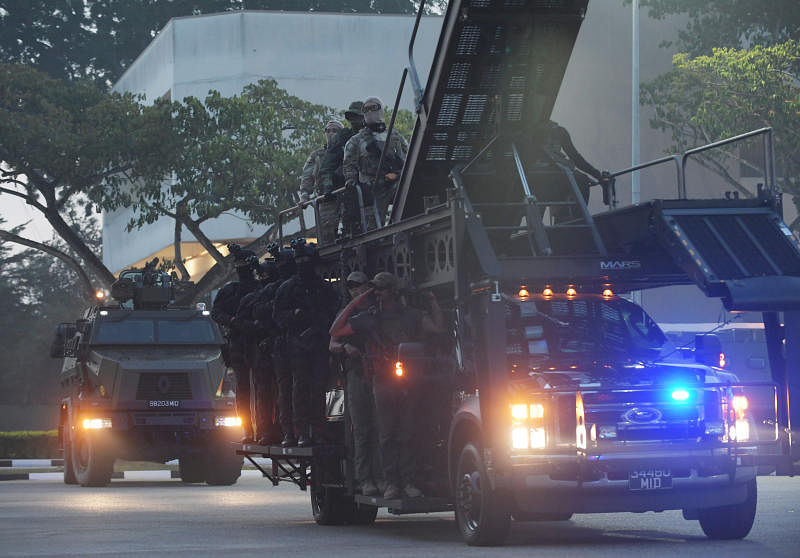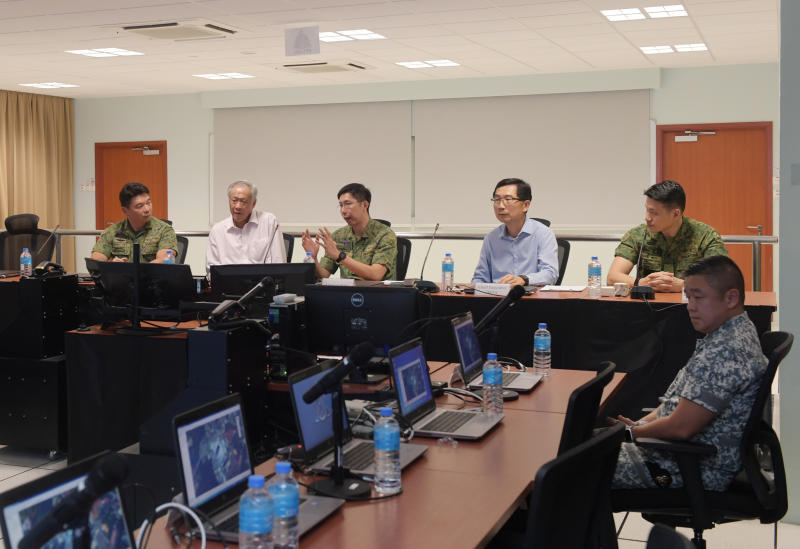SAF commissions Special Operations Command Centre as commandos celebrate golden jubilee
Sign up now: Get ST's newsletters delivered to your inbox
Follow topic:
SINGAPORE - A new command centre commissioned on Wednesday (Dec 4) will allow the Singapore Armed Forces' Special Operations Task Force (SOTF) to execute counter-terrorist operations in a faster and more lethal way, and with less manpower.
Drawing different sources of information from other government agencies and from its own drones, the Special Operations Command Centre will be able to plan, monitor and manage multiple homeland security incidents in different areas.
When activated, the centre can receive live feed from multiple incident sites to allow planners at the centre to assess the situation in real time.
The imagery collated there can also be shared with soldiers on the ground to improve their situational awareness.
Defence Minister Ng Eng Hen commissioned the centre, which is located at Hendon Camp in Loyang, on Wednesday (Dec 4).
He later officiated at the commando formation's 50th anniversary parade.
He said that to respond to the growing terrorist threat, the commandos must evolve their strategies, capabilities and tactics.
They have incorporated new sensors and other equipment into their arsenal in line with technological advances, he said.
"The inauguration of the Special Operations Task Force's Special Operations Command Centre represents an important step in the commandos' response to present-day security threats," he said in a speech at the parade.

ST PHOTO: ALPHONSUS CHERN
Dr Ng added that the centre can process large amounts of data and information from sensors employed to provide a quick assessment of the situation to help commanders decide on the best course of action.
The SOTF was set up in 2009, bringing together elite units within the SAF under one command to tackle terrorist threats.
It combines different units, such as the commandos and special operations forces from the Singapore Army, the Naval Diving Unit, and assets from the army, navy, and air force.
Previously, the SOTF coordinated operations from a mobile command post that is deployed on-site.
This took time to deploy, could be hampered by the weather, and could also be limited by the terrain.
With the new centre, which took about four years to develop with the Defence Science and Technology Agency (DSTA), there will no longer be a need for the mobile command post.
Commander of the Special Operations Task Force, Colonel Kenny Tay, said the unit uses unmanned systems, artificial intelligence and data analytics to deal with the ever-changing terrorist threat.
"This allows SOTF to see better, act faster, to be more effective, more surgical and lethal," he told reporters during a media preview on Monday.
The SOTF has its own surveillance capability, such as the recently acquired Rapide-i4 unmanned aerial system made by local aerospace precision engineering firm Flare Dynamics.
The drone is a weather-proof system armed with cameras to conduct surveillance both in the day and at night, and can be connected to the command centre.
Col Tay added that since the SOTF's inauguration in 2009, it has executed multiple operations with the Home Team and learnt that having a central centre will allow the SAF to better support the national counter-terrorism response.
"With (the new centre), it allows us to conduct distributed operations. Whatever intelligence and information we put up in (the centre) can then be sent to the command element on the ground so that they can see exactly what we see," he added.
The SOTF coordinates with the Singapore Police Force when deploying for homeland security operations.
The task force is usually deployed at significant national events such as the Trump-Kim Singapore Summit last year and the National Day Parade.
Mr Ng Wee Kwang, 44, who is programme manager for national security at DSTA, said that as the planning and coordination of SOTF operations are a complex effort, the DSTA team met the unit frequently to understand its process and requirements.
Mr Ng, who has worked on this project for the last three years, said the centre pulls together data sources from different assets and platforms to give them a comprehensive situational picture.
"At the same time, we harness data analytics to give them key insights to enable the commanders to make a more well-informed decision," he said.

Also present at the commandos' anniversary parade on Wednesday were Chief of Army, Major-General Goh Si Hou, senior defence officials, and commando pioneers.
In his speech, Dr Ng said commandos and special forces units in militaries all over the world hold pride of place as an elite group of soldiers who are called upon to execute the most difficult of missions.
Their impact far exceeds their numbers and their victories can have an uplifting effect on the morale of the entire army, he said.
"The expectations placed on commandos are therefore always high, which explains why their selection criteria and training are so rigorous, even unforgiving."
The commandos are experts in specialised operations such as raids, reconnaissance and enemy interdiction via the land, air and sea. They are trained to operate deep in enemy territories.
In 1969, then Defence Minister Goh Keng Swee headed the establishment of the elite unit, which was formed on Dec 1 that year and had comprised 10 officers and 20 other servicemen.
Dr Ng said that three operations exemplified the modus operandi of the soldiers with the red berets, namely the Laju ferry hijack incident of 1974, the arrival of Vietnam War refugees by boats in Singapore the following year, and the hijack of flight SQ117 in 1991, where a team of commandos freed the passengers and crew in an operation that took just 30 seconds.
He said he recounted these operations not because these events were when the lives of SAF soldiers were put at risk.
"These brave escapades are instead a reminder that there will be moments in Singapore's history, and in our future, where the brave and daring actions of a few are needed to save the lives of many, and to act as the sharp end of the spear for the SAF," he said.
The commando formation calls for a special breed of men and women, who are physically and mentally agile, to respond at quick notice, and act deliberately and decisively under great pressure, said Dr Ng.
"Singaporeans stand behind you, admire your courage and daring, as they do every National Day Parade, enthusiastically and with great pride in greeting the Red Lions descending from the sky, as if propelled by an invincible all-powerful force."
He expressed hope that the commandos will "serve as a fearsome reminder to those who would do harm to Singapore and Singaporeans; to stand guard, ever vigilant, poised to attack when called upon, 'for Honour and Glory'".

